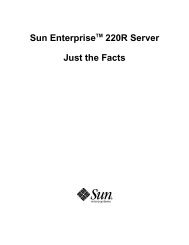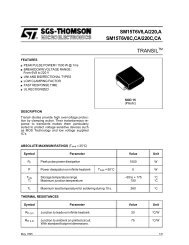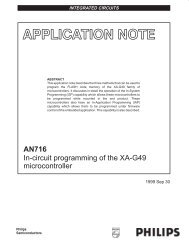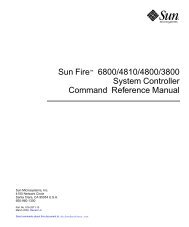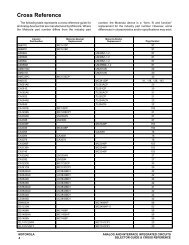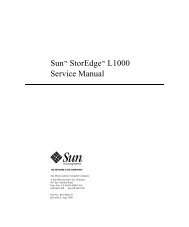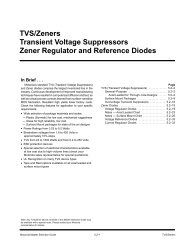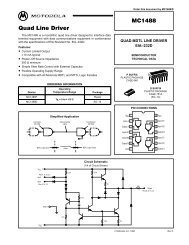MAX192 Low-Power, 8-Channel, Serial 10-Bit ADC - Robotics UWA
MAX192 Low-Power, 8-Channel, Serial 10-Bit ADC - Robotics UWA
MAX192 Low-Power, 8-Channel, Serial 10-Bit ADC - Robotics UWA
Create successful ePaper yourself
Turn your PDF publications into a flip-book with our unique Google optimized e-Paper software.
<strong>Low</strong>-<strong>Power</strong>, 8-<strong>Channel</strong>,<strong>Serial</strong> <strong>10</strong>-<strong>Bit</strong> <strong>ADC</strong><strong>MAX192</strong>Table 4a. Unipolar Full Scale and Zero ScaleREFERENCEZEROSCALEFULL SCALEInternal Reference 0V +4.096VTable 4b. Differential Bipolar Full Scale, Zero Scale,and Negative Full ScaleREFERENCENEGATIVE ZEROFULL SCALE SCALEFULL SCALEInternal Reference -4.096V / 2 0V +4.096V / 2ExternalReferenceat REFADJat VREF0V0VV REFADJ (1.678)V REFat -1/2V REFADJ+1/2V0VREFADJExternal REFADJ (1.678)(1.678)Referenceat VREF -1/2 V REF 0V +1/2 V REFconversion. Tying DIN to +5V feeds in control bytes of$FF (HEX), which trigger single-ended conversions onCH7 in external clock mode without powering downbetween conversions. In external clock mode, theSSTRB output pulses high for one clock period beforethe most significant bit of the conversion result comesout of DOUT. Varying the analog input to CH7 shouldalter the sequence of bits from DOUT. A total of 15clock cycles is required per conversion. All transitionsof the SSTRB and DOUT outputs occur on the fallingedge of SCLK.How to Start a ConversionA conversion is started on the <strong>MAX192</strong> by clocking acontrol–byte into DIN. Each rising edge on SCLK, withC — S – low, clocks a bit from DIN into the <strong>MAX192</strong>’s internalshift register. After – C — S – falls, the first arriving logic“1” bit defines the MSB of the control byte. Until thisfirst “start” bit arrives, any number of logic “0” bits canbe clocked into DIN with no effect. Table 3 shows thecontrol-byte format.The <strong>MAX192</strong> is compatible with Microwire, SPI, andQSPI devices. For SPI, select the correct clock polarityand sampling edge in the SPI control registers: setCPOL = 0 and CPHA = 0. Microwire and SPI bothtransmit a byte and receive a byte at the same time.Using the Typical Operating Circuit, the simplest softwareinterface requires only three 8-bit transfers to performa conversion (one 8-bit transfer to configure the<strong>ADC</strong>, and two more 8-bit transfers to clock out the12-bit conversion result).Example: Simple Software InterfaceMake sure the CPU’s serial interface runs in mastermode so the CPU generates the serial clock. Choose aclock frequency from <strong>10</strong>0kHz to 2MHz.1) Set up the control byte for external clock mode,call it TB1. TB1 should be of the format:1XXXXX11 binary, where the Xs denote the particularchannel and conversion-mode selected.2) Use a general-purpose I/O line on the CPU topull C –— S – on the <strong>MAX192</strong> low.3) Transmit TB1 and simultaneously receive a byteand call it RB1. Ignore RB1.4) Transmit a byte of all zeros ($00 HEX) andsimultaneously receive byte RB2.5) Transmit a byte of all zeros ($00 HEX) andsimultaneously receive byte RB3.6) Pull C –— S – on the <strong>MAX192</strong> high.Figure 6 shows the timing for this sequence. BytesRB2 and RB3 will contain the result of the conversionpadded with one leading zero, two sub-LSB bits, andthree trailing zeros. The total conversion time is a functionof the serial clock frequency and the amount ofdead time between 8-bit transfers. Make sure that thetotal conversion time does not exceed 120µs, to avoidexcessive T/H droop.Digital OutputIn unipolar input mode, the output is straight binary(Figure 15). For bipolar inputs in differential mode, theoutput is twos-complement (Figure 16). Data is clockedout at the falling edge of SCLK in MSB-first format.Internal and External Clock ModesThe <strong>MAX192</strong> may use either an external serial clock orthe internal clock to perform the successive-approximationconversion. In both clock modes, the external clockshifts data in and out of the <strong>MAX192</strong>. The T/H acquiresthe input signal as the last three bits of the control byteare clocked into DIN. <strong>Bit</strong>s PD1 and PD0 of the controlbyte program the clock mode. Figures 7 through <strong>10</strong>show the timing characteristics common to bothmodes.<strong>10</strong> ______________________________________________________________________________________





